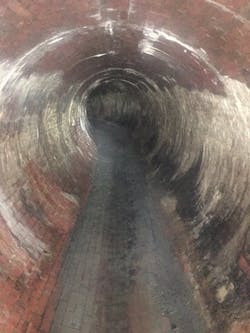Albany Trunk Sewer Rehabilitation
Cost: $1,043,000
Location: Albany, N.Y.
Year: 2019-12-01
Size: 100,000 gpm
Owner: Albany Department of Water & Water Supply
Designers: Albany Water Department
Contractor: Arold Construction
Albany Department of Water & Water Supply maintains a combined sewer system containing major components more than 100 years old. Leading up to this project, Albany faced emergency projects with two major sinkholes in Beaver Creek Combined Sewer District, a network providing sanitary sewer and storm drainage for more than 5 sq miles of Albany. The Beaver Creek District’s sewer network infrastructure dates back to trunk sewers built as early as the 1850s.
The Albany Water Board contracted a third-party inspection and assessment of approximately 2,600 ln ft of sewer within the Beaver Creek Sewer District. Built around 1895, the majority of the combined sewers inspected were 84 in. diameter brick or monolithic concrete. A segment of 48-in. by 60-in. oblong brick sewer on Warren Street also was inspected. All inspections were performed by manned entry pipe walks.
The key features of this project are the stabilization and rehabilitation of aging and failing structures with careful attention to dewatering and flash flood safety measures while also minimizing disruption to residents and businesses. The department implemented a structural, cost-effective, trenchless sewer rehabilitation solution with a small staging area and short cure time for this purpose.
In affected neighborhoods, the combined sewers typically run directly under street center lines, and right-of-ways are relatively narrow. These are older neighborhoods with minimal setbacks and houses tend to be built near property lines, which means limited staging areas or road closures.
Many sections of large diameter brick sewers were found to be failing, with visible mortar loss and cracks. There also were longitudinal fractures at pipe crowns running continuously along entire sewer sections, with bricks starting to fall out, indicating severe risk of failure and collapse.
Crews took special measures to stabilize them before rehabilitating with a centrifugally cast concrete pipe (CCCP) system. The crown fractures were filled with a specialized fine aggregate composite concrete (FACC) using a hand sprayer. Flexible basalt grid, which does not corrode or pull apart, was pinned over that for reinforcement.
Reliable dewatering was critical for this project. The bypass system needed to handle daily flow, as well as sudden floods from storm events. The depth of the sewers, 25 to 30 ft below ground, added complexity to every aspect. Bypass pumping with submersible pumps ensured dry sewers during two to three hour FACC curing windows. A collapsible weir was deployed upstream in less than a minute during a storm event to protect new concrete layers and allow crews to evacuate. Several storms thoroughly tested the reliability and functionality of this system.
Despite an unusually stormy season, work was completed on schedule, including an emergency change order. The repair should add 50 to 75 years to the lifespan of the sewers.
Project Year: 2019-12-01Contractor: Arold Construction Designers: Albany Water Department Owner: Albany Department of Water & Water Supply Location: Albany, N.Y. Cost: $1,043,000 Size: 100,000 gpm